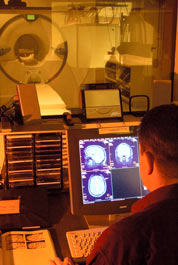

Forensics //
Forensics Research at MRN
MRN’s forensic program continues to expand in both size and scope as investigators try to shed light on the underlying causes of anti-social behaviors. Crime is estimated to cost society more than $2.3 trillion a year, and MRN researchers are hoping to discover some of the neurobiological correlates of the behaviors that cause this huge economic and societal burden.
MRN’s forensic research team now involves more than 40 investigators and staff. Through the use of a unique mobile MRI system, over 3000 brain scans have been collected on location at adult and adolescent correctional facilities, representing the largest set of neuroimaging data ever collected from forensic populations.
Dr. Kent Kiehl is the lead scientist of MRN’s forensic program and the Director of MRN’s mobile imaging core. A large part of Dr. Kiehl's research program has focused on the neurobiology underlying psychopathic traits and behavior among criminal offenders. “Our studies lead us to believe psychopathic behavior results from disruptions to the parts of the brain that regulate emotion, attention, decision making and other cognitive functions,” Dr. Kiehl said. When presented with a series of words intended to invoke an emotional response, psychopaths show deficits in the paralimbic regions when processing ‘emotional’ words but show greater activity in lateral frontal areas, which are considered classic language areas. “Putting it simply, they use emotional regions less, and tend to employ non-emotional areas to do the processing,” Kiehl explains. “Once we understand what causes abnormal behaviors, we can then work to more effectively diagnose and treat these disorders.”
Another member of the team, Dr. Carla Harenski, has expanded on Kiehl’s research by studying social cognition and moral judgment in psychopaths. “The psychopath’s emotional deficits interfere with the development of normal moral socialization, beginning in childhood. As a result, they are incapable of appreciating the consequences of committing harmful, immoral actions.” While the brain systems underlying moral judgment in non-antisocial populations have been established, how these systems function in psychopaths is less known. “With the mobile scanner, we have been able to explore these questions by studying incarcerated psychopaths.” In Dr. Harenski’s work she has found that psychopaths, relative to non-psychopaths, show abnormal activity in paralimbic brain regions when they view pictures depicting moral violations (e.g. one person intentionally causing harm to another).
The team has also conducted neuroimaging studies of criminal offenders with substance use disorders and psychotic disorders. Recent studies have examined whether brain imaging measures collected pre-release from incarceration can help to predict and evaluate relapse to substance abuse after release. Another study identified neural predictors of future recidivism. Identifying neural markers of antisocial behavior has wide-ranging implications for forensic issues and public policy, and Dr. Kiehl is actively involved in initiatives aimed at studying how neuroscience is changing the legal system.
Antisocial behavior is often early emerging, beginning in childhood. It is important to understand how psychopathic and other antisocial traits develop over time, and whether interventions can successfully modify harmful trajectories. One of Dr. Kiehl's currently funded research grants is designed to measure changes in brain structure and function as high-risk youth progress through a novel and groundbreaking state treatment program at the Mendota Juvenile Treatment Center in Madison, Wisconsin.
The overall goal of the forensic research program is to use advanced neuroimaging methods to study, understand, and improve outcomes for high-risk individuals within adult and juvenile justice systems.
Research //
- Addiction & Forensics Research >
- Structural and Functional Differences in the Psychopathic Brain >
- Development of Behavioral Prediction Models >
- Neurobiology of Social Emotion and Cognition in Criminal Offenders with Psychosis >
Addiction & Forensics Research
Substance use disorders have received increasing, well-deserved attention from both researchers and public policy makers due to the detrimental and costly impact drugs of abuse have on individuals and society. Substance dependence is often characterized by compulsive use of a substance that provides short-lived pleasure and relief of anxiety, despite being aware of the harmful effects of these substances and the negative impact that it has on one’s life. Nearly 80% of incarcerated populations meet criteria for a drug and/or alcohol use disorder, and our established relationships with prisons across the country is a valuable resource for conducting research into the neural and psychological factors which promote substance abuse. One promising avenue of this research examines functional brain activity during expectancy of reward and while monitoring conflicting influences over behavior in tasks which require specific responses. Psychopathy is also strongly associated with substance abuse. With access to genetic data, brain data, and long-range behavioral outcomes of those who struggle with substance abuse, we are developing more sophisticated models of the factors contributing to this problem, which may highlight the most promising strategies for prevention and treatment.
Structural and Functional Differences in the Psychopathic Brain
Psychopaths are characterized by developmental neural impairments affecting paralimbic regions of the brain, which impair a wide range of cognitive functions. These deficits often instigate patterns of antisocial deviance, but also promote a unique set of personality traits which distinguish psychopaths from the more typical criminal offender. Psychopaths are characteristically clever and even charming while simultaneously lacking empathy and remorse, embodying a callous willingness to exploit others for personal gain. More subtle deficits can be isolated and measured with carefully controlled experimental tasks, and these include fundamental cognitive processes like target detection, response inhibition, error-monitoring, and language-semantic processing. Our research is aimed at elucidating the nature of structural and functional differences in the brains of psychopaths, determining how these contribute to problems with cognitive function as well as socio-emotional function (e.g., emotion perception and understanding, moral sensitivity and judgment, empathy and perspective taking). We examine the development of these deficits from youth to maturity, studying juveniles and adult inmates, both male and female, strategically identifying neurocognitive features which impair normal brain development and distinguishing psychopaths from the everyday criminal offender.
Development of Behavioral Prediction Models
A great deal of research has been devoted to identifying patterns of brain structure and function that characterize subgroups of antisocial populations, such as psychopathic and substance-dependent individuals. Our recent research has progressed towards moving beyond this descriptive research, using what has been learned to establish methods for the prospective analysis of specific outcomes of interest. Our lab has collected the world’s largest multimodal database of neuroimaging, genetic information, and clinical assessments for thousands of incarcerated individuals, which grows larger every day. This database has provided a unique capacity to develop highly reliable models which can effectively predict the likelihood of outcomes such as recidivism, treatment success, and relapse based on brain structure, brain function, genetic information and clinical assessment data. Recent research in our lab has demonstrated the promising relative utility of functional brain activity in establishing these predictions, as it has the advantage of being a proximal measurement of cognitive processes that would directly contribute to these outcomes. Effectively predicting complex behavioral outcomes such as recidivism might prove to be a key factor in choosing appropriate intervention strategies based on physical characteristics of the brain and its function.
Neurobiology of Social Emotion and Cognition in Criminal Offenders with Psychosis
This COBRE-funded project led by Dr. Carla Harenski is designed to study social emotion and cognition (SEC) in forensic psychiatric populations. SEC impairment is a prominent feature of psychotic disorders, particularly schizophrenia (SZ), but the behavioral and neural correlates of SEC in SZ relative to other psychotic disorders is not well understood. There is also a lack of research examining the association between SEC deficits and dimensions of psychosis symptomatology (e.g., positive vs. negative symptoms). To date, most studies of SEC in psychosis have been conducted in community populations, with less attention directed towards forensic or criminal populations due to the practical challenges of conducting neuroimaging studies in secure institutions and prisons. Criminal offenders with psychotic disorders may show particularly severe neurobehavioral deficits in SEC, but this has not yet been studied. This project capitalizes on the availability of the mobile MRI system, which has been deployed to several secure forensic psychiatric and prison facilities to study criminal offenders with and without psychotic disorders. Structural and functional MRI is being used to examine the neural circuitry underlying higher-order SEC processes (emotion perception, understanding, and perspective taking) and associations with psychosis, mood, and aggression symptoms. The results of this study are expected to provide a novel dataset in an understudied forensic criminal population that will elucidate the nature of SEC among different types and features of psychosis.

